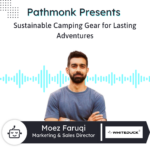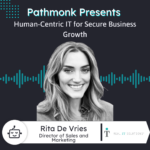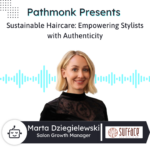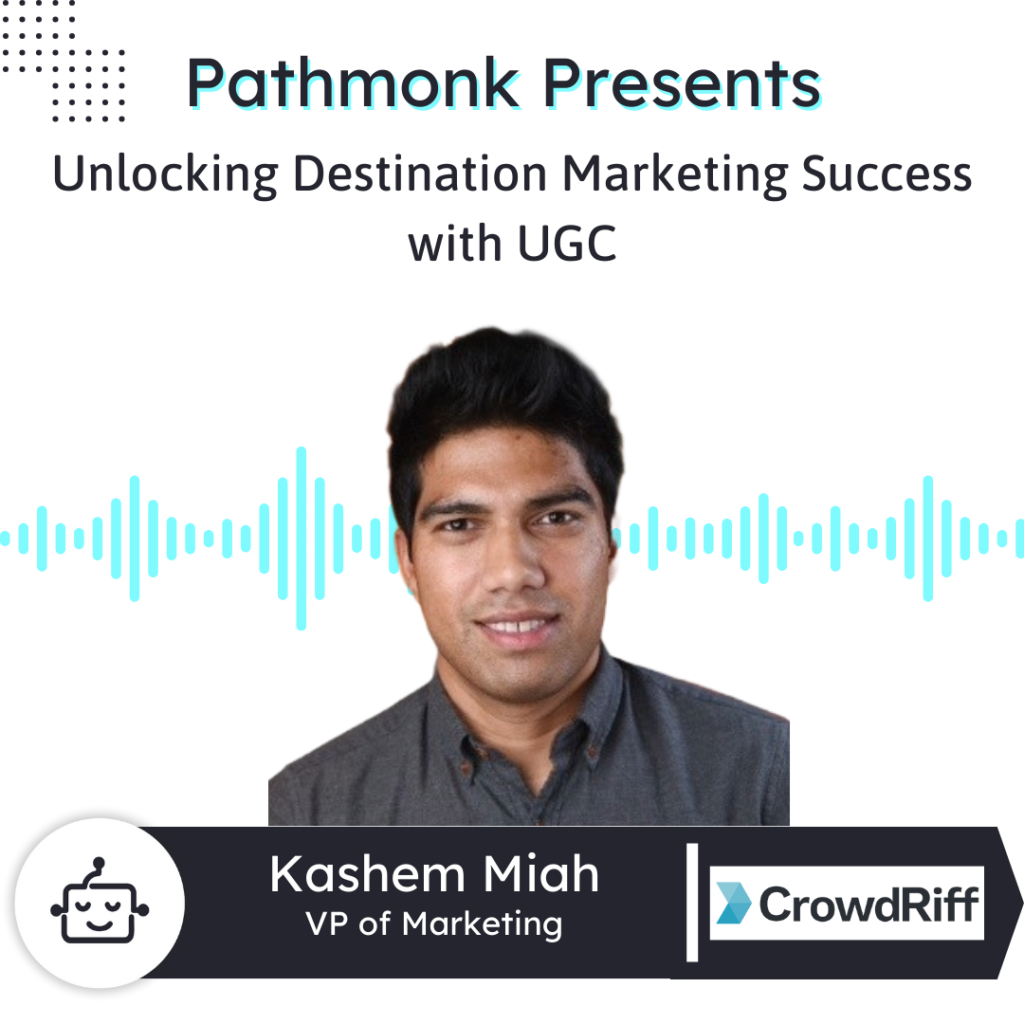
Introduction
Kashem Miah, as VP of Marketing, offers insider insights into CrowdRiff’s operations and strategies.
Kashem explains how authentic, traveler-generated photos and videos can be more persuasive and engaging than traditional marketing materials. He discusses how CrowdRiff’s platform helps destination marketers efficiently find and utilize user-generated content (UGC) across various marketing channels.
If you’re a destination marketer looking for valuable insights, don’t miss this episode!
More Sales From Your Website With AI
Personalized interactions based on your users' behaviour to get +50% more conversions.
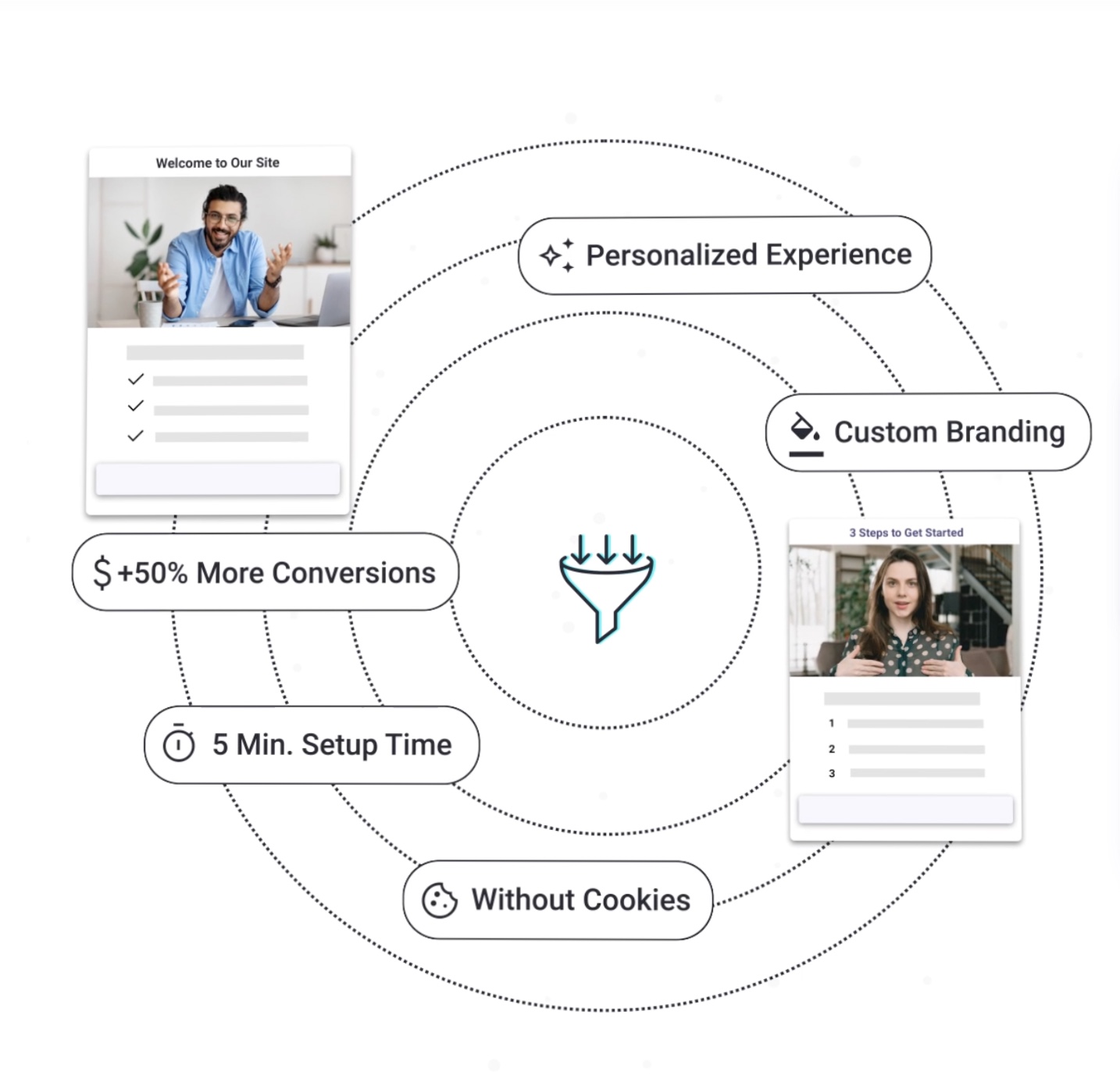
Ernesto Quezada: Pathmonk is the intelligent tool for website lead generation. With increasing online competition, over 98% of website visitors don’t convert. The ability to successfully show your value proposition and support visitors in their buying journey separates you from the competition online. Pathmonk qualifies and converts leads on your website by figuring out where they are in the buying journey and influencing them in key decision moments. With relevant micro experiences like case studies and videos and much more, stay relevant to your visitors and increase conversions by 50%. Add Pathmonk to your website in seconds. Let the AI do all the work and get access to 50% more qualified leads while you keep doing marketing and sales as usual. Check us on pathmonk.com. Welcome to today’s episode. Let’s talk about today’s guest. We have Kashem from CrowdRiff, VP of Marketing out there with them. How are you doing today, Kashem?
Kashem Miah: I’m doing well. Thank you so much for having me.
Ernesto: It’s a pleasure to have you on, someone with so much expertise. Definitely. And well, we are looking forward to learning a little bit more about CrowdRiff as well. So, let’s kick it off with that. Kashem, in your own words, can you tell us a little bit more?
Kashem: Sure. So CrowdRiff is a SaaS solution that lets destination marketers find UGC content anywhere online, social channels, or you connect with local creators to create assets that could be used across all marketing channels. So you go in, you get what you want, and then you can use it across social, website, email, etc. Think of us a little bit like HubSpot for destination marketers, where we provide you a solution to be able to create content and distribute it across different channels.
Ernesto: Yeah, awesome. In today’s world, in the marketing world, I think everybody’s looking for tools like that. So awesome to hear that. So then, and so that way our listeners can get a good understanding of CrowdRiff, what would you say is the key problem that you guys like to solve for clients?
Kashem: Yeah. So we serve a very specific niche marketer. They are the destination marketers. Funny enough, I didn’t even know who they were until I started to interview at the company. So destination marketers are crucial within the travel space. They are responsible for helping bring tourism to local destinations. Think of your local city, county, state, and they are responsible for promoting those destinations. We serve them through our solution, helping them with great content. We just make it easier for them to find the right content so they can do their job better, which is making sure that they can promote their destination to any traveler that is either thinking about visiting or maybe putting it on a list of destinations they want to visit at a later point.
Ernesto: All right, perfect. Awesome. Great to hear that. You did mention a couple of DMOs or the verticals that you guys like to go for. So would that be your ideal ICP or are there sometimes other vertical segments that you guys go for?
Kashem: Yeah, so right now it’s mostly that destination marketer within the DMO organization. But because we are in the travel space, we do go into other segments. We have worked with travel agencies, attractions, hotels, and resorts. In some cases, we’ve also worked with airlines. Because the travel experience touches everyone and DMOs are at the heart of it, we do get into other spaces and it’s an area that we’ve talked about potentially getting into even more, but right now we’re solely focused on serving the DMOs as best as we can.
Ernesto: Okay, perfect. Awesome. So, how would somebody usually find out about CrowdRiff? Say, I was in the hotel industry and I’m looking for a solution. Is there a top client acquisition channel for you guys?
Kashem: Yeah, so CrowdRiff has done a really good job over the years, even before I joined, of participating at events. We are typically at most of the big industry events, we’ve sponsored a number of them. Because of the word of mouth at those events and we have a number of customers, we’ve done a really good job of building that brand equity through word of mouth with these existing customers who are willing to give us case studies, who are willing to refer us to their peers. I’d say more recently, especially after Covid, when events shut down, we’ve seen an uptick in organic reach, organic social, and more importantly, paid channels. We’ve increased our reliance on paid channels to reach more of these destination marketers across different channels. But we still see events starting to play a bigger role. We’re obviously participating in more events now. So it’s a combination of offline and online. Offline just gives you that added benefit of being able to meet some of these prospects in person and actually have a dialogue with them about what those challenges are. So yeah, it’s a combination of those channels, but really the brand equity with the in-person meetings have come a long way.
Ernesto: Definitely would agree. And so that way our listeners who are tuned in could go in and visit you. You could always check them out at crowdriff.com. What role then does the website play for client acquisition?
Kashem: Yeah, so for us, think of it as a place to validate everything they’ve heard at events or they’ve seen in an ad, or maybe a peer has sent them an article. We typically look at our website as the validation engine. If you were a direct-to-consumer company, you go to the website, you’d need to look at all these different storytelling mechanisms of who they are, their journey, all of that. I think for us, it’s a little bit less of that. We are trying to get destination marketers really quickly to trust us that we are going to help them do their job well and then use case studies, use a bunch of different things to validate that particular need for them. So for us, it’s really just about that trust and validation. We see our existing customers also value the information our website provides. So we’re also trying to mimic some of the experiences that they provide travelers. We know that the website is really important to them. So we’re trying to provide a similar value to our customers who will come to our website for the first time and quickly browse through it and make a decision one way or another. Are we going to be able to give them the right type of support so that they can promote their destination?
Ernesto: Okay, awesome. Great to hear that. Then on that note, is there any tools or tips or methods that you would recommend to our listeners as far as some website lead generation?
Kashem: Yeah. When I talk about trying to avoid telling this bigger vision, I don’t think that applies to everyone. Different companies have different ways of making sure the prospects that get on their website can quickly understand what they’re trying to buy or what they will buy at the end. I think for us, it’s really focusing on showcasing ROI. Show the numbers, show the impact that you can actually have for a potential prospect. Also, show actual case studies. For us, the trust factor, the peer recommendations, those are huge. Our prospects really appreciate when a peer recommends us. So we try to populate as many case studies as we can. If you go to our website, you’ll see a number of case studies, a number of quotes, and those are high up on the website along with numbers. Those are things that you should keep in mind. In terms of tools, we use tools like Hotjar to just understand where people spend time. That understanding lets us know how much information they are really consuming, how much information they are putting into a form, where they drop off. It also helps us build the right workflows. It gives our demand gen team a better understanding of whether we need to make forms longer or shorter, and how much content we actually need to get in front of these potential prospects. Hotjar is one tool that we really look at. There are a bunch of other ones that we’re working through, like Clearbit is another one that we’ve explored in the past. You need to have the right tools to be able to look at where your customers are spending time. But I’d say, more importantly, just focus on things that your customer wants. They want to understand if you can actually help them. Show the ROI and then show them other case studies to validate whether or not they can trust you.
Ernesto: Okay, awesome. Great insights there for our listeners. Well, let’s switch gears a little bit, Kashem, and let’s focus on your day-to-day work. I mean, you being the VP of Marketing at CrowdRiff, what does that look like?
Kashem: Yeah, so my day-to-day task is a little bit interesting. I try to start my day off with a walk. I have two young kids. I drop them off at school. Just detaching myself from the home to work is really important. That walk sort of, that walk in between really makes a big difference. On a day-to-day basis, it’s going through all of the communication channels that we have at CrowdRiff and making sure that I’m not missing anything that I can do to help my team. Are there blockers that I can unblock really quickly so that my team can move faster? Then I take a look at a couple of different things that matter to the team and to the business. Are we pacing in our North Star metric? Are we hitting our qualified leads? Are we doing those things on a regular basis to make sure the sales team can continue doing their work? Then I spend a lot of time with the leadership team. I am on the leadership team. We are constantly trying to figure out how to improve the product, how to improve our margins, all the things that you can expect a SaaS company to be thinking about. A lot of those discussions. But I’d say, right away, it’s just, can I get my team to move faster? And what are the things that I can do to help unblock their tasks?
Ernesto: Definitely. Okay, great to hear that. In the meantime, Kashem, how do you stay up to date with all the news in the marketing world, trends, and strategies? Is there a preferred channel that you like to go with?
Kashem: I wouldn’t say there’s a preferred channel. I do consume a lot of content online, from traditional sources like New York Times, to tech sites like TechCrunch, Reddit, to industry sites. Because the travel site has industry-specific news like Skift.com, I go to those sites a lot. I also follow a lot of organizations within those industries on LinkedIn, Twitter, and Threads. They also have newsletters. I consume a ton of content and it keeps me informed about what’s going on. We’re also fortunate to have a number of employees who previously worked in the DMO space, so they’re also a good resource to tap into whenever I’m debating about something or just want to validate whether or not what I hear in the news is actually true.
Ernesto: Okay, perfect. Great to hear about those channels that you like. Well, let’s jump into our next section then, Kashem, which is the rapid-fire question round. Are you ready for them?
Kashem: Sure. Let’s do it.
Ernesto: Awesome. First off, Kashem, what is the last book that you read?
Kashem: Ooh, I just finished “Going Infinite” by Michael Lewis. It’s the book about SBF. Really good read. I was at a beach. Finished it really quickly. Awesome read.
Ernesto: Okay, great read there for our listeners. Next up, Kashem, what is one single thing that your company is focused on the most at the moment?
Kashem: Yeah, we are focused on really trying to understand how to provide more verticalized products for existing customers. We have two existing products we’re working on, potentially two more. That is the sole focus: what can we do to keep going upstream with our existing customer base?
Ernesto: Awesome. Great to hear that. Next, if there were no boundaries in technology, what would be that one thing that you want to have fixed for your role as a marketer today?
Kashem: Yeah, it’s funny. I actually think it’s good to have some of these boundaries. Without boundaries, it’s unimaginable what could be possible in the space. We absolutely need those boundaries. But to answer your question, I’d say the practical answer would be just better profiling of our customers so we can spend less money on ads with just better targeting. But the more personal, theoretical answer would be to get rid of all these ad tools and just make more creative stuff. As I’ve gotten older as a marketer, great creative really stands out. It’s weirdly less noisy and it cuts through so much better. I think of those products that I enjoy the most. I collect sneakers, I have tons of clothing that I’m very particular about, and they’re just very simple, creative that connects and I just get it. In a boundary-less world within this space, I would just hope that there’s more creative that is generated versus just focusing on so many of these ad tools.
Ernesto: Definitely. Awesome. Great to hear that, Kashem. Next, if there’s one repetitive task that you could automate, what would that be?
Kashem: Ooh, so earlier I mentioned I’m constantly looking at these different channels to make sure I can help my team. I would love it if there was one place where everything could be served to me from all the Slack messages, Asana tasks, emails that essentially just have one-word responses or thumbs-up emoji. That would be amazing for me, especially at the start of the day because I know there are things coming in that the team just needs to move ahead on. That would be perfect. Like a dashboard with just 20 different things to start the day. Thumbs up, thumbs down, yes or no, and we’re good to go.
Ernesto: Definitely important. I would agree with you on that. So many tools out there that we need one to compile them into one. That’d be great. Lastly, Kashem, you have a lot of experience already in the marketing world, but what is that one piece of advice that you would give yourself if you were to restart your journey as a marketer today?
Kashem: Yeah, so the one thing I would say, looking back, is just focus on controlling what you can. I’ve had a strange journey across multiple different companies, different segments, but knowing what I know now, if I could go back, I would tell myself to just focus on controlling what you can, and everything else will take care of itself. As a young marketer, you want to do everything. You push the wrong button sometimes, and you worry about the outcomes. It’s really hard when you’re worrying so much about what you’ve done wrong instead of focusing on what you can do really well. Continue to do that as best as you can instead of what could theoretically be possible in a new role or at a new company. I think we lose track of that as marketers. Just do what you do really well, and other things will continue to open up. So I think it’s more about that control. If I could do it, control it, do it well, and things will just open up.
Ernesto: Okay, perfect. Thank you so much for sharing that. Well, Kashem, we are coming to the end of the show here. But before we do end, I do want to give you the last word. If someone forgets everything about the interview today, what is that one thing they should remember about CrowdRiff?
Kashem: I think they should remember that CrowdRiff is the only place where you’ll get the type of content you need to promote your destination. If you think about destination marketing, CrowdRiff is synonymous with destination.
Ernesto: Definitely. Awesome. Great to hear that from you, Kashem. I do appreciate you giving us the time to be on today’s episode. To our listeners, thank you so much for tuning in, and we’ll see you on our next episode at Pathmonk Presents. Thanks a lot, Kashem.
Kashem: Thank you so much for having me again. Appreciate it.




